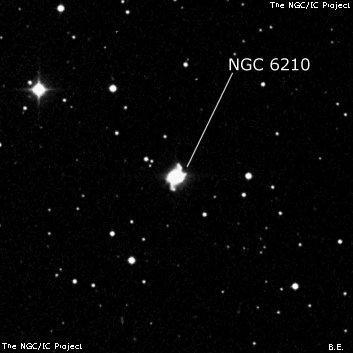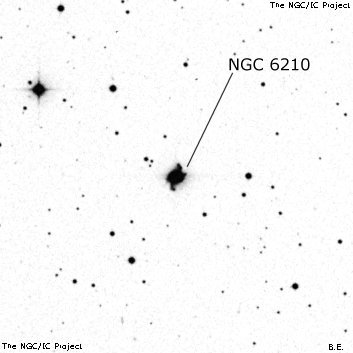NGC/IC Project Restoration Effort
(This is a very very beta version)
NGC6210


Basic Information
Location and Magnitude
Right Ascension: 16:44:29.5
Declination: +23:48:2
Constellation: HER
Visual Magnitude: 8.8
Historic Information
Discoverer: Struve W.
Year of discovery: 1825
Discovery aperture: 9.6
Observational
Summary description: planetary, vB, vS, R, disc ___DREYER___ border
Sub-type: PN
Steve's Notes
=====
NGC 6210
48" (5/5/16): at 488x; extremely bright, high surface brightness planetary, oval 5:4 WSW-ENE, somewhat rectangular main body. The central star was continuously visible and situated slightly east of center. A small darker region surrounds the central star. On close inspection the main body has an irregular outline, is slightly brighter along the north side and bulges out on the southwest end. A thin fainter "strip" or shell with a much lower surface brightness and a pinkish color encases the main body. Two or three broad "jets" or wings (broadest at the base) extend out of the halo on the north and south ends (images show the central part is NNW and SSE) with the northern wing more obvious. A third wing was sometimes visible on the west side.
24" (6/12/15): at 375x and 500x; slightly elongated oval disc E-W or WSW-ENE. The very high surface brightness central region is encased in a small, but obvious lower surface brightness shell. Extremely faint "wings" appear to extend to the north and south, though the northern extension is more definite. These are roughly in the direction of the minor axis.
28" (7/8/13): viewed at 375x with an "inverse OIII" or central star filter, which dramatically dimmed this extremely high surface brightness green planetary. Without the filter the central star was not seen at this magnification (the planetary had a strong green color), but with the filter the central star was easily visible!
18" (7/20/06): appears as a beautiful light blue cosmic egg at 225x with an extremely high surface brightness. Appears slightly elongated ~E-W, ~25"x20" with a very faint thin outer envelope. At 325x and 435x the faint outer halo is obvious, increasing the size ~35"x28" with the elongation possibly WSW-ENE. Viewed in fairly poor seeing on 7/20 but on 7/22 in good seeing I was able to use as much as 807x. With these better conditions the surface brightness was irregular and the faint outer shell fairly prominent. The bright inner disc was oval but not symmetric.
17.5" (5/27/00): beautiful bluish oval at 220x, elongated 4:3 E-W, roughly 24"x18". At 380x, there appears to be a very small fainter halo. At 500x, the narrow outer envelope is more evident and is elongated in the direction of the major axis, increasing the size to ~30"x20".
17.5" (7/4/86): very bright, small blue oval 20"x15" with an unusually high surface brightness. At 572x, a fainter outer envelope is suspected. An evenly matched close double star ·2094 = 7.4/7.7 at 1.3" lies 17' SSW.
13.1" (7/5/83): very bright, extremely high surface brightness, blue, takes very high power. The mag 12.6 central star was not seen.



